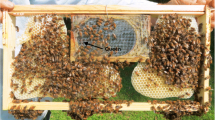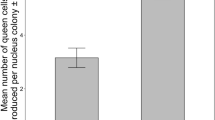Abstract
Due to a continuing shift toward reducing/minimizing the use of chemicals in honey bee colonies, we explored the possibility of using small cell foundation as a varroa control. Based on the number of anecdotal reports supporting small cell as an efficacious varroa control tool, we hypothesized that bee colonies housed on combs constructed on small cell foundation would have lower varroa populations and higher adult bee populations and more cm2 brood. To summarize our results, we found that the use of small cell foundation did not significantly affect cm2 total brood, total mites per colony, mites per brood cell, or mites per adult bee, but did affect adult bee population for two sampling months. Varroa levels were similar in all colonies throughout the study. We found no evidence that small cell foundation was beneficial with regard to varroa control under the tested conditions in Florida.

Similar content being viewed by others
References
Aliano NP, Ellis MD (2005) A strategy for using powdered sugar to reduce varroa populations in honey bee colonies. J Apic Res 44:54–57
Burgett M, Burikam I (1985) Number of adult honey bees (Hymenoptera:Apidae) occupying a comb: a standard for estimating colony populations. J Econ Entomol 78:1154–1156
Camazine S (1986) Differential reproduction of the mite, Varroa jacobsoni (Mesostigmata:Varroidae), on Africanized and European honey bees (Hymenoptera:Apidae). Ann Entomol Soc Am 79:801–803
Delaplane KS, Hood WM (1997) Effects of delayed acaricide treatment in honey bee colonies parasitized by Varroa jacobsoni and a late-season treatment threshold for the southeastern USA. J Apic Res 36:125–132
Delaplane KS, Hood WM (1999) Economic threshold for Varroa jacobsoni Oud. in the southeastern USA. Apidologie 30:383–395
Erickson EH, Lusby DA, Hoffman GD, Lusby EW (1990) On the size of cells. Speculations on foundation as a colony management tool. Part II Gleanings Bee Cult 118:173–174
Fakhimzadeh K (2001) Effectiveness of confectioner sugar dusting to knock down Varroa destructor from adult honey bees in laboratory trials. Apidologie (Celle) 32:139–148. doi:10.1051/apido:2001119
Fuchs S (1990) Preference for drone brood cells by Varroa jacobsoni Oud in colonies of Apis mellifera carnica. Apidologie (Celle) 21:193–199. doi:10.1051/apido:19900304
Issa MRC, De Jong D, Gonclaves LS (1993) Reproductive strategies of the mite Varroa jacobsoni (Mesostigmata, Varroidae): influence of larva type and comb cell size on honey bee brood infestation rates. Rev Bras Genet 16:219–224
Martin JM, Kryger P (2002) Reproduction of Varroa destructor in South African honey bees: does cell space influence Varroa male survivorship? Apidologie (Celle) 33:51–61. doi:10.1051/apido:2001007
McMullan JB, Brown MJF (2006a) The influence of small-cell brood combs on the morphometry of honeybees (Apis mellifera). Apidologie (Celle) 37:665–672. doi:10.1051/apido:2006041
McMullan JB, Brown MJF (2006b) Brood-cell size does not influence the susceptibility of honey bees (Apis mellifera) to infestation by tracheal mites (Acarapis woodi). Exp Appl Acarol 39:273–280. doi:10.1007/s10493-006-9017-2
Message D, Goncalves LS (1995) Effect of the size of worker brood cells of Africanized honey bees on infestation and reproduction of the ectoparasitic mite Varroa jacobsoni Oud. Apidologie (Celle) 26:381–386. doi:10.1051/apido:19950503
Oliver R (2008) A trial of HoneySuperCell® small cell combs. Am Bee J 148:455–458
Pettis JS, Jadczak T (2005) Detecting coumaphos resistance in Varroa mites. Am Bee J 145:967–970
Pettis JS, Kochansky J, Feldlaufer MF (2004) Larval Apis mellifera L. (Hymenoptera: Apidae) mortality after topical application of antibiotics and dusts. J Econ Entomol 97:171–176. doi:10.1603/0022-0493(2004)097[0981:PROCMC]2.0.CO;2
Piccirillo GA, De Jong D (2003) The influence of brood comb cell size on the reproductive behavior of the ectoparasitic mite Varroa destructor in Africanized honey bee colonies. Genet Mol Res 2:36–42
Sammataro D, Gerson U, Needham G (2000) Parasitic mites of honey bees: life history, implications, and impact. Annu Rev Entomol 45:519–548. doi:10.1146/annurev.ento.45.1.519
Skinner JA, Parkman JP, Studer MD (2001) Evaluation of honey bee miticides, including temporal and thermal effects on formic acid gel vapors, in the central south-eastern USA. J Apic Res 40:81–89
SAS Institute (2002–2003) SAS/STAT user’s guide, version 9.1. SAS Institute, Cary
Acknowledgements
Tom Dowda provided technical assistance with colony care and data collection. Various members of FDACS Apiary Inspection, FDACS Bureau of Methods Development and Biological Control, and University of Florida Honey Bee Research and Extension Laboratory assisted in data collection. Funding was provided by the Florida State Beekeepers Association and the Florida State Legislature as directed by the Florida Honey Bee Technical Council.
Author information
Authors and Affiliations
Corresponding author
Rights and permissions
About this article
Cite this article
Ellis, A.M., Hayes, G.W. & Ellis, J.D. The efficacy of small cell foundation as a varroa mite (Varroa destructor) control. Exp Appl Acarol 47, 311–316 (2009). https://doi.org/10.1007/s10493-008-9221-3
Received:
Accepted:
Published:
Issue Date:
DOI: https://doi.org/10.1007/s10493-008-9221-3




